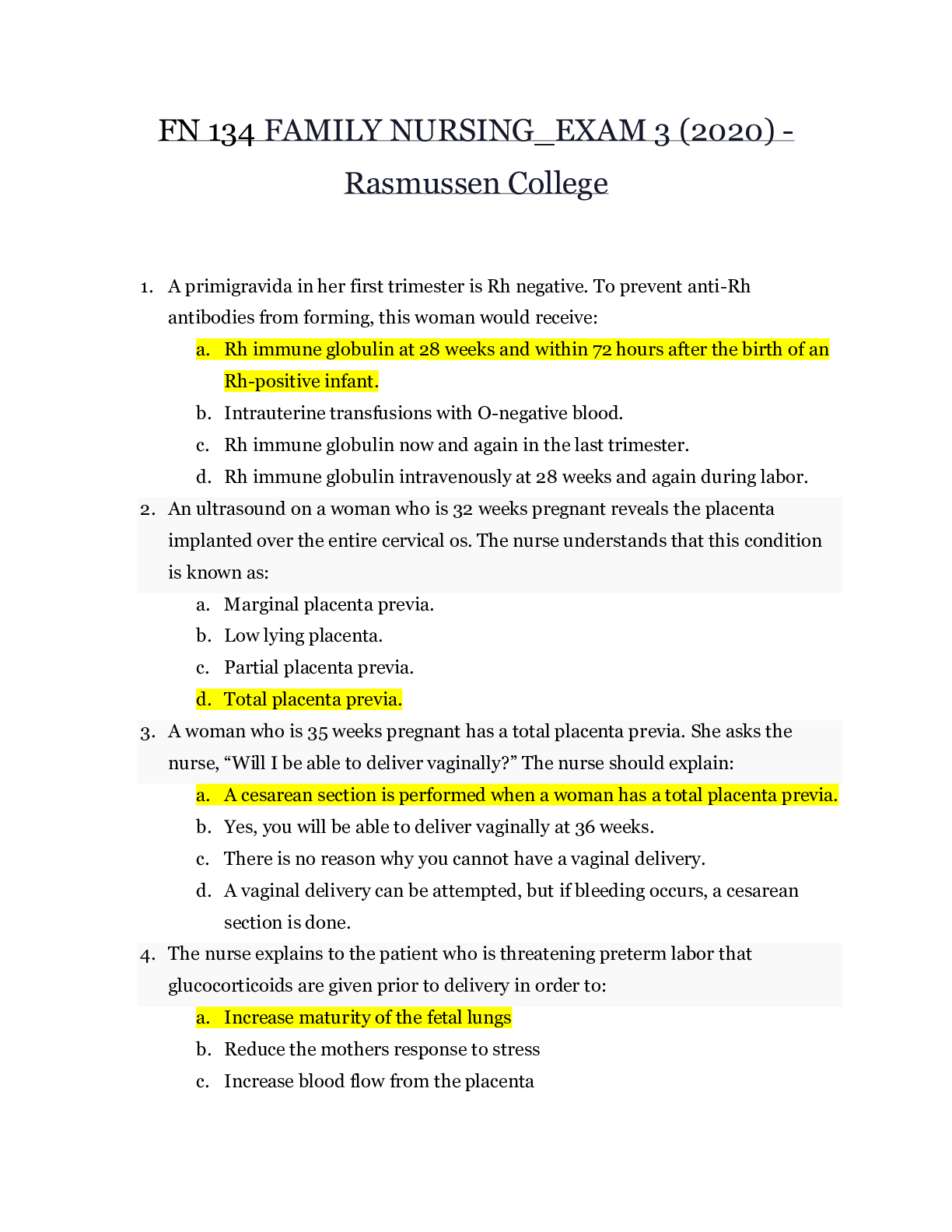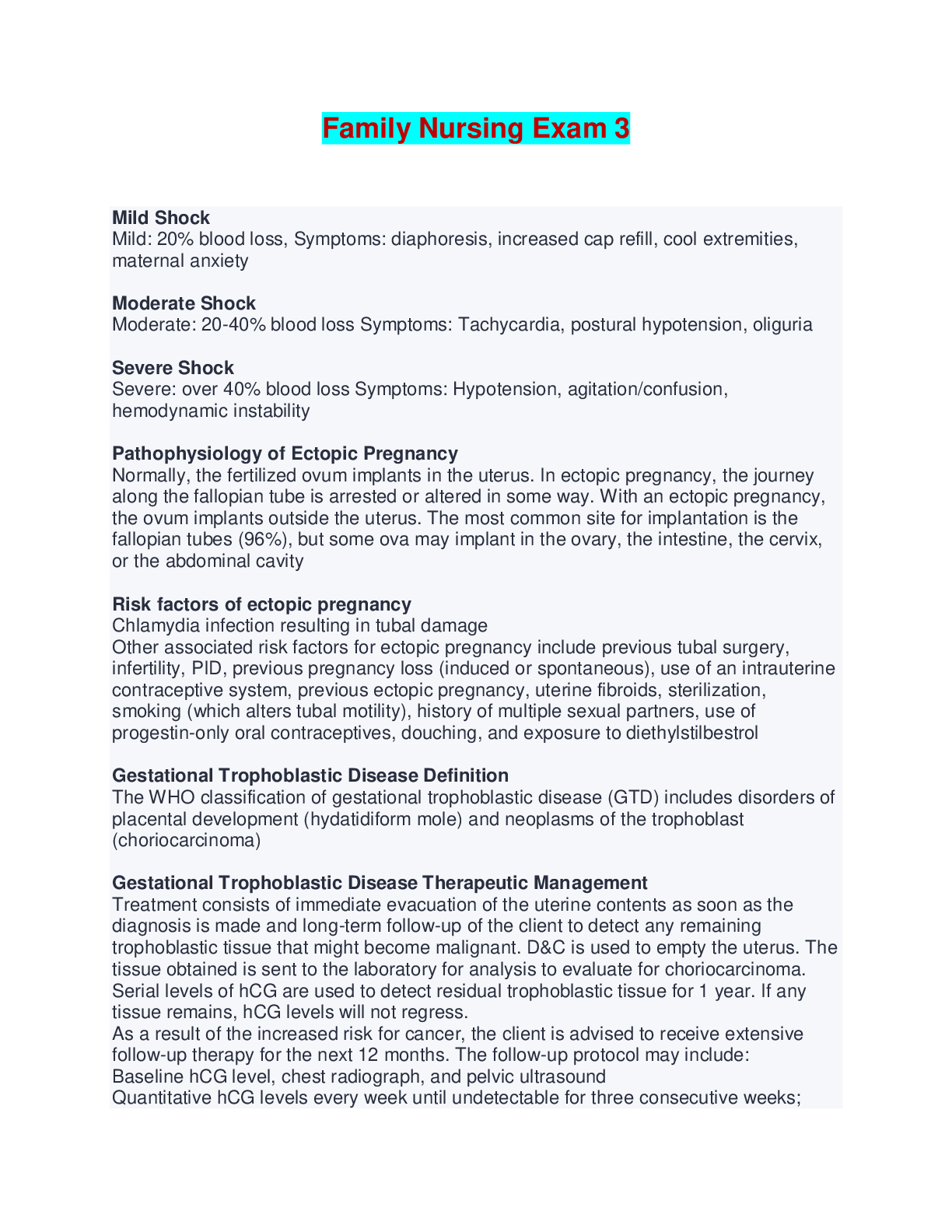*NURSING > EXAM > FN 134 FAMILY NURSING_EXAM 3 (2020) - Rasmussen College | FN134 FAMILY NURSING_EXAM 3 (2020) (All)
FN 134 FAMILY NURSING_EXAM 3 (2020) - Rasmussen College | FN134 FAMILY NURSING_EXAM 3 (2020)
Document Content and Description Below
FN 134 FAMILY NURSING_EXAM 3 (2020) - Rasmussen College 1. A primigravida in her first trimester is Rh negative. To prevent anti-Rh antibodies from forming, this woman would receive: a. Rh immune... globulin at 28 weeks and within 72 hours after the birth of an Rh-positive infant. b. Intrauterine transfusions with O-negative blood. c. Rh immune globulin now and again in the last trimester. d. Rh immune globulin intravenously at 28 weeks and again during labor. 2. An ultrasound on a woman who is 32 weeks pregnant reveals the placenta implanted over the entire cervical os. The nurse understands that this condition is known as: a. Marginal placenta previa. b. Low lying placenta. c. Partial placenta previa. d. Total placenta previa. 3. A woman who is 35 weeks pregnant has a total placenta previa. She asks the nurse, “Will I be able to deliver vaginally?” The nurse should explain: a. A cesarean section is performed when a woman has a total placenta previa. b. Yes, you will be able to deliver vaginally at 36 weeks. c. There is no reason why you cannot have a vaginal delivery. d. A vaginal delivery can be attempted, but if bleeding occurs, a cesarean section is done. 4. The nurse explains to the patient who is threatening preterm labor that glucocorticoids are given prior to delivery in order to: a. Increase maturity of the fetal lungs b. Reduce the mothers response to stress c. Increase blood flow from the placenta d. Relax the cervical opening 5. A woman seeking prenatal care relates a history of macrosomic infants, two stillbirths, and polyhydramnios with each pregnancy. The nurse recognizes that these factors are highly suggestive of: a. Toxoplasmosis b. Abruptio placenta c. Diabetes mellitus d. Hydatidiform mole --- wrong 6. A pregnant woman who has recently immigrated to the United States comments to the nurse, “I am afraid of childbirth. It is so dangerous. I am afraid I will die.” A nursing response reflecting cultural sensitivity would be: a. Anesthesia is available to relieve pain during labor and childbirth b. Your condition will be monitored during labor and delivery c. Tell me why you are afraid of childbirth d. Maternal mortality in the US is extremely low 7. The nurse reminds family members that the philosophy of family-centered care is to give them control over their health care decisions. This control is called: a. Nursing excellence b. Empowerment c. Critical thinking d. Enabling 8. Several hours after delivery the nurse finds a woman crying. The woman says repeatedly, “My baby is beautiful, but I was planning on a vaginal delivery. Instead I needed an emergency C-section.” The most appropriate nursing diagnosis is: a. Grieving related to loss of expected birth experience b. Anxiety related to the development of postpartum complications c. Risk for ineffective parenting related to emergency cesarean section d. Ineffective individual coping related to unfamiliarity with procedures 9. A pregnant patient tells the nurse that she has been nauseated and vomiting. The nurse explains that hyperemesis gravidarum is distinguished from morning sickness because: a. Sensitivity to smells is usually the cause of vomiting in hyperemesis gravidarum b. Hyperemesis gravidarum causes dehydration and electryolyte imbalances c. Hyperemesis gravidarum usually lasts for the duration of the pregnancy d. The woman with hyperemesis gravidarum will have persistent vomiting without weight loss 10. The nurse would suspect pyelonephritis when a pregnant woman reports: a. Burning sensation when she urinates b. Nausea and weight loss c. Tenderness in the flank area d. Urinary frequency and urgency 11. The nurse assesses a pregnant woman for pregnancy-induced hypertension. The first sign of fluid retention suggestive of this complication is: a. Abdominal swelling b. Gradual weight gain c. Swelling of the feet and ankles ----- wrong d. Sudden weight gain 12. The nurse caring for a pregnant woman receiving an intravenous infusion with magnesium sulfate will: a. Count respirations and report a rate of less than 12 breaths/min b. Measure urinary output and report a rate of less than 100 mL/hr c. Monitor fetal heart rate and report a rate of less than 140 beats/minute d. Monitor blood pressure and report a reading of less than 140/80 13. The nurse explains that the objective of magnesium sulfate therapy for the patient with preeclampsia is to: a. Prevent seizures b. Regulate blood pressure c. Act as a saline cathartic d. Increase reflex irritability 14. The drug the nurse plans to have available for immediate IV administration whenever magnesium sulfate is administered to a maternity patient is: a. C = Calcium gluconate 15. The intervention that is most effective in dealing with occasional aggression in a 4-year-old child is to: a. D - Have the child take a time-out in the corner for 4 minutes 16. The young prenatal patient with gestational diabetes mellitus (GDM) says, “I am frightened that I will have to deal with insulin injections for the rest of my life.” The nurse’s best response would be: a. D – it will most likely resolve 6 weeks or so after the baby is born 17. Several hours after delivery the nurse finds a woman crying. The woman says repeatedly, “My baby is beautiful, but I was planning on a vaginal delivery. Instead I needed an emergency C-section.” The most appropriate nursing diagnosis is: a. B – grieving related to the loss of expected birth experience 18. The best response to a postpartum woman who tells the nurse that she feels “tired and sick all of the time since I had the baby 3 months ago” is: a. C = Let’s talk about this further. I am concerned about how you are feeling. 19. One day after discharge, the postpartum patient calls the clinic complaining of a reddened area on her lower leg, temperature elevation of 37 ° C (99.8° F), rust-colored lochia, and sore breasts. From these symptoms, the nurse suspects: a. Not C = puerperal infection 20. A nurse is preparing to discharge a woman with gestational diabetes who delivered a ten pound baby boy three days ago by Cesarean Section. Which of the following teaching is correct? a. C = Do not lift anything heavier than the baby for six weeks. 21. The nurse explains to the patient who is threatening preterm labor that magnesium sulfate is given prior to the woman in preterm labor, in order to: a. Not C – maintain adequate blood pressure 22. The nurse is caring for a woman who was delivered by Cesarean Section 8 hours ago. The nurse realizes that she should consider which of the following when assessing the fundus of the uterus? a. Not C = the procedure for checking the fundus of the uterus is the same for this patient as it is for a vaginal delivery 23. A student nurse is trying to remember the difference between placenta previa and abruption of placenta. She chooses symptoms of placenta previa from the following list (Select all that apply). a. Painless, Bright red bleeding 24. A nurse is caring for a five year old child who is scheduled for repair of an inguinal hernia in one week. Which of the following teaching is most appropriate for the child before the surgery? a. B = the child may learn best by playing with puppets or dolls 25. The anxious parent asks if there is a danger of her 2-year-old child becoming addicted to the opioid pain reliever following surgery. The nurse’s most helpful response would be: a. D = addiction is rare in children when opiates are given for pain 26. A seven year old girl is being discharged from the hospital following emergency surgery for appendicitis. Which of the following should the nurse teach the family (select all that apply)? a. Monitor for signs of infection such as fever, keep the incision clean and dry, manage the childs pain with medications 27. The nurse planning a safety program for high school students should understand that most accidental deaths in adolescence are related to: a. C = automobiles 28. A 9-year-old boy is often cranky and irritable and his school performance has declined. All the options are true about the child. The possible factor causing this behavior is that he: a. D = sleeps only 6-7 hours per night 29. The best choice for fluid replacement that the nurse can offer a child who has just had a tonsillectomy is: a. A = a green popsicle 30. A new mother is demonstrating understanding of discharge teaching. Which of the following indicates that she needs further teaching? a. A = I will burp the baby after every 2 ounces of formula intake [Show More]
Last updated: 1 year ago
Preview 1 out of 5 pages
Instant download

Buy this document to get the full access instantly
Instant Download Access after purchase
Add to cartInstant download
Reviews( 0 )
Document information
Connected school, study & course
About the document
Uploaded On
Aug 04, 2020
Number of pages
5
Written in
Additional information
This document has been written for:
Uploaded
Aug 04, 2020
Downloads
0
Views
53
















